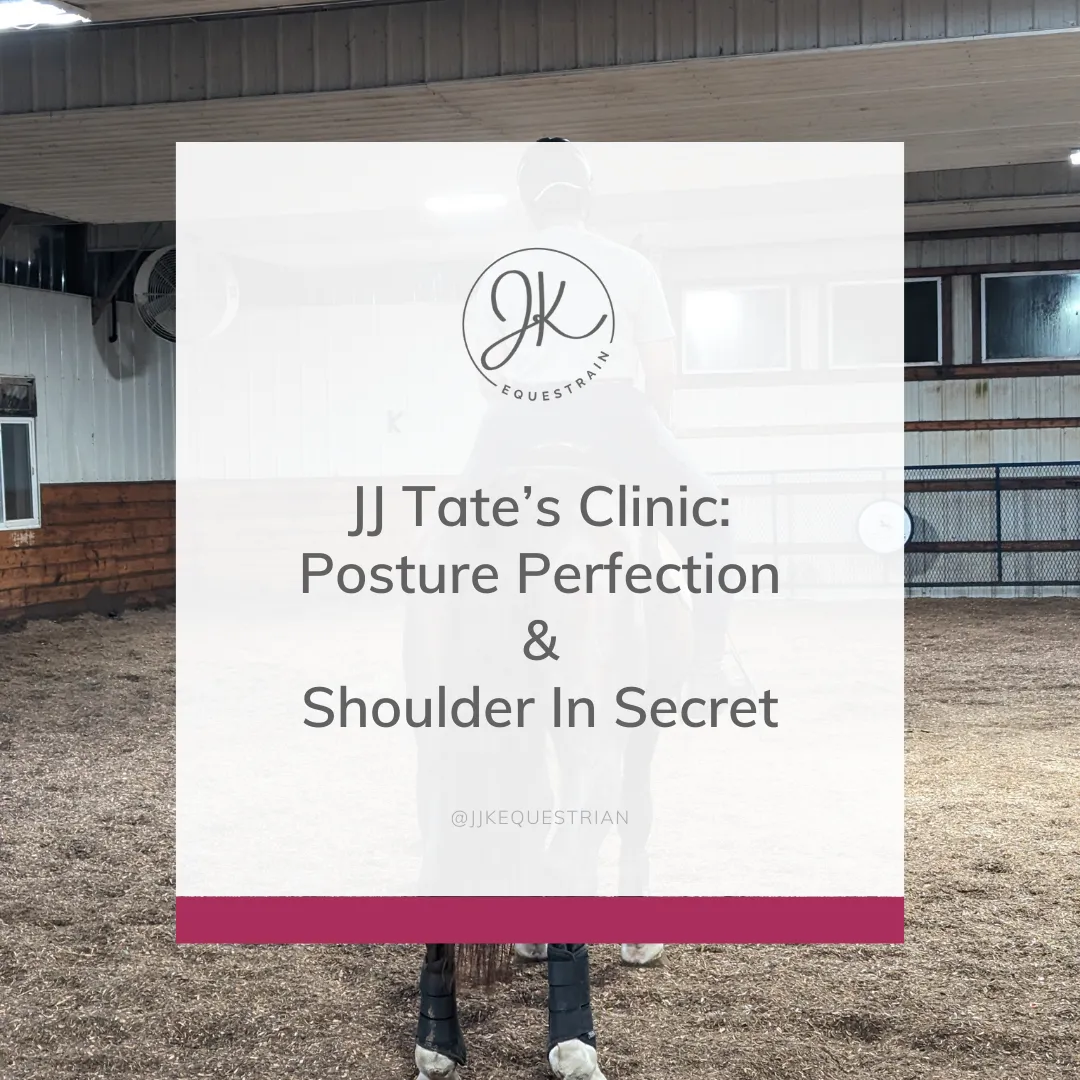JJK Equestrian Blog
Where Passion Meets the Saddle

Training Integrity: Insights from JJ Tate's Clinic at Wild Rose Farm
Hey there, fellow equestrians! So, I recently met a friend at a local dressage clinic, she raved about how amazing the clinician was and how I just HAD to come watch and learn. So I headed to the beautiful Wild Rose Farm, and let me tell you, the one and only JJ Tate made it an eye-opening experience. Strap in, because I'm about to share some game-changing insights that I picked up during this clinic.
First off, let's talk about something JJ emphasized right from the get-go: the importance of synchronizing your seat with your horse's tempo, especially during the canter. Picture this: your seat should move slower than the tempo of your horse's canter. It's all about finding that sweet spot where you're in tune with your horse's rhythm without getting ahead of them.
Now, onto the side pass. JJ gave us a fantastic tip: when practicing this movement, ask for four strides rides and then stop asking. It's about giving your horse clear cues and then allowing them the time and space to respond. Remember, patience is key in dressage!
One of the biggest takeaways for me was JJ's emphasis on not picking fights with your horse. If your horse isn't being dishonest, don't go looking for trouble. Trust me, it'll save you both a lot of unnecessary stress and frustration.

Let's talk about the horse's back for a moment. JJ explained that the higher your horse's back goes up and is used, the more their large joints can bounce and swing. This really drove home the importance of riding with intention and correct biomechanics to optimize our horse's movement.
Now, when it comes to riding your horse's neck up or down, JJ had some valuable insights. She encouraged us to vary our horse's neck position and avoid staying in the middle. Beware of that middle ground—it's where you might encounter resistance or tension.
Have you ever wondered how to tell if your horse is engaging their core? JJ had a brilliant nugget of wisdom: your horse is on their core when you can hardly hear their canter. It's all about listening to the subtleties of their movement.
Here's a neat trick for checking your horse's collection: when looking at your horse head-on, in true collection, their nostrils should be in the center of their chest, with no head tilting left or right. It's a quick visual check to ensure you're on the right track.
Weight aids are crucial in dressage, and JJ broke it down for us. There are three ways to change your weight in the saddle: use your inside leg at the girth, use your outside leg behind the girth, and turn your body in the saddle. Simple yet effective techniques to communicate with your horse.
Now, let's talk about gathering up your reins. JJ shared a fantastic visualization: think a little bit shoulder in to start engaging the inside hind leg, and give your horse time to react to the connection. It's about setting them up for success and allowing them to find their balance.
I've been consistently applying this concept with Indra, given her tendency to carry her head high and her neck positioned above her shoulders. This approach allows her the necessary time to reposition her body and engage her core, preventing any abrupt movements that might result in her pulling on the reins. As a result, we've reached a significant milestone where I can now cue her with just a hint of inside leg and rein, and she responds by willingly lowering her head and lifting her rib cage, achieving a more collected frame effortlessly. It's a testament to the progress we've made through patient and consistent training.
Straightness is key in dressage, both for the rider and the horse. JJ likened it to four triangles: two pointing down towards your hips and two sitting on your hips pointing up towards your shoulders. The goal? Keep those triangles intact and avoid collapse or tilting.
And finally, mastering the shoulder in at the walk and trot serves as a precursor to achieving the ideal canter position for your horse, even though it's not explicitly in the canter gait itself. By perfecting the shoulder in at slower gaits, you're laying the foundation for your horse to effortlessly transition into the correct canter position when the time comes. This insight highlights the interconnectedness of dressage movements and how mastering one element can significantly impact your horse's performance in others.
This revelation completely revolutionized my approach to asking Indra for her canter. Given her high sensitivity, any external pressure from my outside leg would inadvertently push her into a half pass or even prompt her to punch into the canter prematurely. It's made me acutely aware that every cue for the canter must be meticulously orchestrated. I've learned to first ask for shoulder in, ensuring her body is correctly aligned, before smoothly transitioning into the canter. This deliberate sequence not only helps her pick up the correct lead but also encourages her to engage her hindquarters and sit on her haunches, rather than relying solely on her front legs. It's all about finesse and precision in our communication, ultimately leading to a more harmonious and polished performance.
So there you have it, folks—some incredible insights from JJ Tate's dressage clinic at Wild Rose Farm. I don't know about you, but I'm feeling inspired and ready to hit the arena with a whole new perspective.
Until next time, happy riding! 🐴
Copyright ⓒ Kopac Enterprises LLC | 2024
Powered By TDMFunnels

